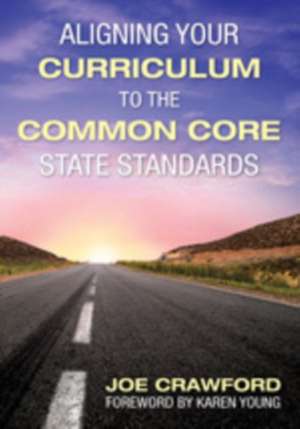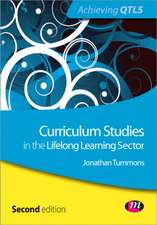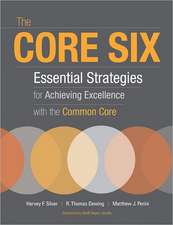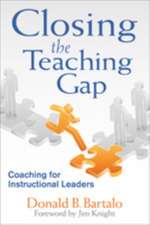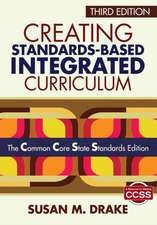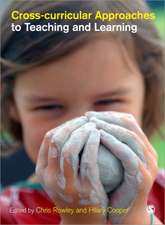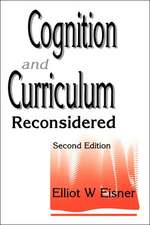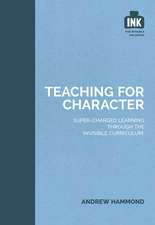Aligning Your Curriculum to the Common Core State Standards
Autor Joe T. Crawforden Limba Engleză Paperback – 9 ian 2012
Preț: 324.92 lei
Nou
Puncte Express: 487
Preț estimativ în valută:
62.18€ • 64.43$ • 51.89£
62.18€ • 64.43$ • 51.89£
Carte tipărită la comandă
Livrare economică 21 martie-04 aprilie
Preluare comenzi: 021 569.72.76
Specificații
ISBN-13: 9781452216478
ISBN-10: 1452216479
Pagini: 248
Ilustrații: Illustrations
Dimensiuni: 178 x 254 x 16 mm
Greutate: 0.5 kg
Ediția:1
Editura: SAGE Publications
Colecția Corwin
Locul publicării:Thousand Oaks, United States
ISBN-10: 1452216479
Pagini: 248
Ilustrații: Illustrations
Dimensiuni: 178 x 254 x 16 mm
Greutate: 0.5 kg
Ediția:1
Editura: SAGE Publications
Colecția Corwin
Locul publicării:Thousand Oaks, United States
Recenzii
“At a time when all of us are seeking clarity and simplicity about the Common Core State Standards (less is more!), Joe Crawford’s book makes a helpful and practical contribution to the work of implementation. His real-school examples help us to see that standards can and must be reduced to be useful.”
"Our teachers are eager to take ownership in curriculum development, and our district looks forward to updating other content areas using the Power Standards model."
"The process and methods that Joe Crawford implemented with our teachers, and his ability to customize the process while working with three different school districts, speaks volumes to the scalability of his Power Standards approach. His work is not just transactional, but truly transformational."
"From developing a system for connecting different assessments and objectives to understanding how CCSS currently works in the real world, this is packed with guidelines suitable for any education collection."
"This readable title is directed toward the implementation leader and is designed as a guide for putting the CCSS into operation. This book is an excellent road map to guide schools and districts beginning to create workable local CCSS."
"Our teachers are eager to take ownership in curriculum development, and our district looks forward to updating other content areas using the Power Standards model."
"The process and methods that Joe Crawford implemented with our teachers, and his ability to customize the process while working with three different school districts, speaks volumes to the scalability of his Power Standards approach. His work is not just transactional, but truly transformational."
"From developing a system for connecting different assessments and objectives to understanding how CCSS currently works in the real world, this is packed with guidelines suitable for any education collection."
"This readable title is directed toward the implementation leader and is designed as a guide for putting the CCSS into operation. This book is an excellent road map to guide schools and districts beginning to create workable local CCSS."
Cuprins
Foreword by Karen Young
Preface
Acknowledgements
About the Author
partners4results Software Availability
1. Overview of CCSS and Associated Leadership Issues
Chapter Expectations
Aciton Steps
Leadership Challenges for Implementing CCSS
What Are Standards?
Develop and Use a Standards-Based Curriculum
Align the Curriculum
Think of Content as a Means to a Performance End
Staff Development Issues
Build Undersanding of the CCSS
Use What Has Already Been Developed as a Basis for Moving Forward
Defining and Creating Local CCSS
Understand Local CCSS (Power Standards)
How to Read These Samples
What Are Instructional Objectives?
Why Are Instructional Objectives So Important?
System Thinking
What About Using National Assessments as Formative Assessments?
What About Accountability?
What About Using the Data?
What About Monitoring?
System Thinking Summarized
Process Summary
Process Checklist
2. Curriculum Issues and a National Curriculum Model
Chapter Expectations
Action Steps
What Is a Curriculum?
Consider Your Options for Defining Curriculum
A New Model for a National Curriculum
New National Model Defined
Process Summary
Process Checklist
3. The Development and Use of Local CCSS, Quarterly Instructional Objectives, and Common Formative Assessments
Chapter Expectations
Action Steps
Build Local CCSS
Design Quarterly Instructional Objectives
Develop Common Formative Assessments
Addressing Formative Assessments Within the Assessment Development Cycle
Address Issues in Creating Common Formative Assessments
Designing Local Assessments
Process Summary
Process Checklist
4. A Sample K-12 Curriculum
Chapter Expectations
Action Steps
Read and Understand the New Model
Accept the Realities of a Sample From Several Districts
How to Read These Samples
Sample K-12 ELA Curriculum
Sample K-12 Math Curriculum
Process Summary
Process Checklist
5. The Journey Ahead
Chapter Expectations
Action Steps
Summary of Issues
Some Specific Issues
Current Reactions
Final Thoughts
Resource A: Collated Feedback on CCSS Work
Resource B: Suggested Forms for Developing Local CCSS (Power Standards) and Instructional Objectives and Feedback Forms
B1: Standards to Local Standards
B2: Follow-Up Process Guidelines for Local CCSS
B3: Quarterly Instructional Objectives, Critical Attributes
B4: Follow-Up Process Guidelines: Instructional Objectives
B5: Initial Distribution Feedback
B6: Local CCSS/Instructional Objectives Quarterly Feedback
B7: Quarterly Assessments Feedback
B8: End-of-Year Feedback
B9: Curriculum Audit: What the Research Tells Us
References and Suggested Readings
Index
Preface
Acknowledgements
About the Author
partners4results Software Availability
1. Overview of CCSS and Associated Leadership Issues
Chapter Expectations
Aciton Steps
Leadership Challenges for Implementing CCSS
What Are Standards?
Develop and Use a Standards-Based Curriculum
Align the Curriculum
Think of Content as a Means to a Performance End
Staff Development Issues
Build Undersanding of the CCSS
Use What Has Already Been Developed as a Basis for Moving Forward
Defining and Creating Local CCSS
Understand Local CCSS (Power Standards)
How to Read These Samples
What Are Instructional Objectives?
Why Are Instructional Objectives So Important?
System Thinking
What About Using National Assessments as Formative Assessments?
What About Accountability?
What About Using the Data?
What About Monitoring?
System Thinking Summarized
Process Summary
Process Checklist
2. Curriculum Issues and a National Curriculum Model
Chapter Expectations
Action Steps
What Is a Curriculum?
Consider Your Options for Defining Curriculum
A New Model for a National Curriculum
New National Model Defined
Process Summary
Process Checklist
3. The Development and Use of Local CCSS, Quarterly Instructional Objectives, and Common Formative Assessments
Chapter Expectations
Action Steps
Build Local CCSS
Design Quarterly Instructional Objectives
Develop Common Formative Assessments
Addressing Formative Assessments Within the Assessment Development Cycle
Address Issues in Creating Common Formative Assessments
Designing Local Assessments
Process Summary
Process Checklist
4. A Sample K-12 Curriculum
Chapter Expectations
Action Steps
Read and Understand the New Model
Accept the Realities of a Sample From Several Districts
How to Read These Samples
Sample K-12 ELA Curriculum
Sample K-12 Math Curriculum
Process Summary
Process Checklist
5. The Journey Ahead
Chapter Expectations
Action Steps
Summary of Issues
Some Specific Issues
Current Reactions
Final Thoughts
Resource A: Collated Feedback on CCSS Work
Resource B: Suggested Forms for Developing Local CCSS (Power Standards) and Instructional Objectives and Feedback Forms
B1: Standards to Local Standards
B2: Follow-Up Process Guidelines for Local CCSS
B3: Quarterly Instructional Objectives, Critical Attributes
B4: Follow-Up Process Guidelines: Instructional Objectives
B5: Initial Distribution Feedback
B6: Local CCSS/Instructional Objectives Quarterly Feedback
B7: Quarterly Assessments Feedback
B8: End-of-Year Feedback
B9: Curriculum Audit: What the Research Tells Us
References and Suggested Readings
Index
Notă biografică
Descriere
Avoid “analysis paralysis” and just get started!
The Milken Award-winning educator and author of Using Power Standards to Build an Aligned Curriculum shows how to implement the new Common Core State Standards. This book outlines his proven process for building a guaranteed and viable local curriculum based on the CCSS, and includes:
- A system for creating local standards from the CCSS
- Methods for connecting the common, formative assessments to quarterly instructional objectives
- Ways to scaffold learning expectations
